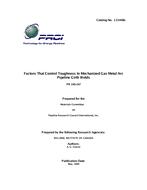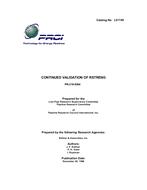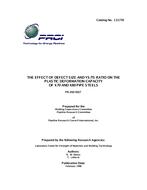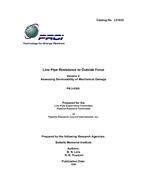Provide PDF Format
PRCI PR-140-147
- Factors That Control Toughness In Mechanized Gas Metal Arc Pipeline Girth Welds
- Report / Survey by Pipeline Research Council International, 05/01/1984
- Publisher: PRCI
$198.00$395.00
L51448e
Welding Institute of Canada
Need: Traditionally the field girth weld has been made using the shielded metal arc process, however increasing use is being made of mechanized gas metal arc welding systems (e.g. the CRC system); this is especially true of large diameter pipeline construction. The mechanized gas metal arc technique utilizes a relatively low heat input process with a variety of wires and gas shielding. These weld deposits are prone to different defects than those for shielded metal arc process, e.g. lack of sidewall fusion, lack of cross weld penetration etc., and the significance of these in terms of structural integrity have been addressed in terms of engineering critical assessments. In order to carry out these assessments the fracture toughness of the weld metals have been measured. This toughness has been measured using the crack tip opening displacement technique and the results have been found to be variable and in some cases poor. To date a systematic investigation of the factors controlling the toughness in these weld metals has not been made. If these factors were known better choice of consumables for mechanized girth welding could be made, based on an understanding of the factors that control fracture.
Result: The objective of this present research program has been to investigate the factors that control the toughness of low heat input gas metal arc welds deposited using a mechanized process. This research program has studied the fracture behavior of a series of mechanized gas metal arc welds made by the CRC process. A total of five wires were used and a sixth experimental wire included for comparison purposes. The wires were chosen to represent the effect of increasing alloy content. From each weld wet chemical analyses were taken together with oxygen and nitrogen analyses.
Benefit: Good control was maintained on the chemistries of the weld metals with the oxygen levels and inclusion volume fractions being similar. The effect of microstructure on toughness was clearly demonstrated whilst the effect of inclusions on toughness was less clear because of the limited range of oxygen levels. The factors that influence weld metal properties are considered to depend on a number of variables and their fracture behavior is explained by referring to a combination of the following:
(a) solidification structure
(b) solid state transformations
(c) precipitation of carbides or nitrides
(d) distributions of inclusions
(e) cooling characteristics of the weld
Welding Institute of Canada
Need: Traditionally the field girth weld has been made using the shielded metal arc process, however increasing use is being made of mechanized gas metal arc welding systems (e.g. the CRC system); this is especially true of large diameter pipeline construction. The mechanized gas metal arc technique utilizes a relatively low heat input process with a variety of wires and gas shielding. These weld deposits are prone to different defects than those for shielded metal arc process, e.g. lack of sidewall fusion, lack of cross weld penetration etc., and the significance of these in terms of structural integrity have been addressed in terms of engineering critical assessments. In order to carry out these assessments the fracture toughness of the weld metals have been measured. This toughness has been measured using the crack tip opening displacement technique and the results have been found to be variable and in some cases poor. To date a systematic investigation of the factors controlling the toughness in these weld metals has not been made. If these factors were known better choice of consumables for mechanized girth welding could be made, based on an understanding of the factors that control fracture.
Result: The objective of this present research program has been to investigate the factors that control the toughness of low heat input gas metal arc welds deposited using a mechanized process. This research program has studied the fracture behavior of a series of mechanized gas metal arc welds made by the CRC process. A total of five wires were used and a sixth experimental wire included for comparison purposes. The wires were chosen to represent the effect of increasing alloy content. From each weld wet chemical analyses were taken together with oxygen and nitrogen analyses.
Benefit: Good control was maintained on the chemistries of the weld metals with the oxygen levels and inclusion volume fractions being similar. The effect of microstructure on toughness was clearly demonstrated whilst the effect of inclusions on toughness was less clear because of the limited range of oxygen levels. The factors that influence weld metal properties are considered to depend on a number of variables and their fracture behavior is explained by referring to a combination of the following:
(a) solidification structure
(b) solid state transformations
(c) precipitation of carbides or nitrides
(d) distributions of inclusions
(e) cooling characteristics of the weld
Related Products
PRCI PR-202-9327
Effect of Defect Size and YS/TS Ratio on the Plastic Deformation Capacity of X70 and X80 Pipe Steels..
$198.00 $395.00
PRCI PR-003-9305
Line Pipe Resistance to Outside Force: Assessing Serviceability of Mechanical Damage..
$298.00 $595.00





